If you enjoy this article, or any other content from this website, please subscribe to the newsletter. Your support can make a big difference!
What is Miso Aubergine?
Marco and I first came across miso-glazed roasted aubergine at Machiya — a Japanese eatery in Picadilly, London and we were smitten.
Miso aubergine (or miso eggplant) is a vegan Japanese side dish called Nasu dengaku (ナスの田楽), which literally means, miso-glazed aubergine.
Miso aubergine is so creamy that you could just tear the flesh away with a pair of chopsticks. The flavour is full of umami — it's both subtly sweet, yet savoury and it's usually topped with shichimi togarashi — a popular Japanese spice containing a mix of ground red chilli pepper and Japanese pepper (sanshō), roasted orange peel, black and white sesame seeds, hemp and poppy seeds, ground ginger and seaweed (nori).
You would typically use Japanese aubergines together with Japanese ingredients like soy, mirin (fermented rice wine) and of course, miso. Miso (fermented soybeans) is commonly classified by its colour, Shiro(white), Aka(red) and Mixed (awase). In this recipe, I use awase, which is a blend of red and white miso.
In my version of miso-glazed aubergine, I adopt a simpler and quicker approach, but no less tasty.
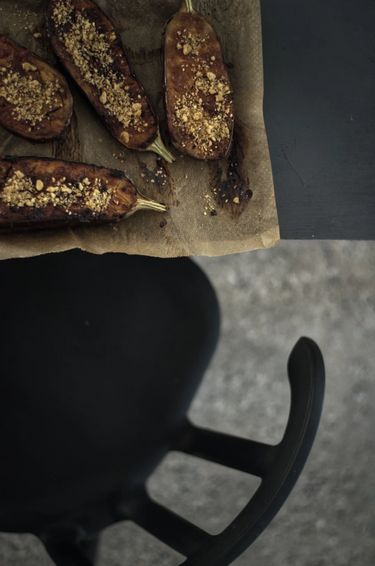
What is the difference between Japanese aubergine vs. regular aubergine?
You may think that each and every aubergine is the same — large, oblong, and deep purple, but there are countless varieties out there, that have their own distinct textures and taste.
The most common variety in Europe are the smaller versions of the larger purple-skinned aubergine, often called Italian or baby aubergine. These have a somewhat more intense flavour and the flesh is much more tender.
The straight thin aubergines known as Japanese or Asian aubergine have thin delicate skins like Italian aubergines, but the flesh is sweeter. The cream-coloured inner flesh is spongy and nearly seedless. When cooked, Japanese aubergines are mild and sweet with a tender, meaty texture.
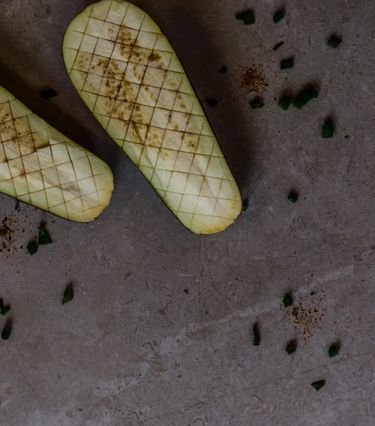
Did you also know that you could identify which aubergines would have more seeds? Aubergines with a round indentation mark at the bottom tend to have fewer seeds than aubergines with an indentation that is elongated.
Having lived in South East Asia, I was also gobsmacked to learn that aubergines are referred to as brinjal. This is not too different from the Maltese word for aubergine, brungiel. How cool is that!!
Can you substitute Japanese aubergine for regular aubergine?
Whilst Japanese aubergine are quick-cooking and have a slightly different texture, I used an Italian aubergine for this recipe and it turned out perfectly fine!
How to Make Miso-Glazed Roasted Aubergine

Making vegan miso aubergine is simple enough, but I wanted to give it a little twist. Instead of adding shichimi togarashi as a topping, I prepared dukkah (duqqa), an Egyptian condiment consisting of a mixture of herbs, nuts, and spices. It is typically used as a dip with bread but it tastes absolutely fantastic with robust flavours like miso-glazed aubergine or this wonderful smoky roasted aubergine dip by My Pure Plants.

How to Prepare the aubergine
You'll definitely want to aim for the aubergine 'meat' to turn into a delicious sweet and buttery soft texture. And you'll achieve that by scoring the aubergine and then slathering with the miso glaze so that it seeps into the gaps.
To score the aubergine, slice the aubergine with the tip of a knife, at a diagonal. Make sure to cut deep but not deep enough that you would tear the skin. Once you have done one side of diagonal slashes, repeat in the opposite direction, until you get a diamond pattern. This will help cook the aubergine better (as steam penetrates the flesh) as well as allowing the miso paste to seep through the scores, adding further depth of flavour.
You could also soak the aubergines in water for about 5 minutes to remove some of its bitterness.
Some recipes suggest that you pan fry the aubergine halves for a few minutes with the lid to begin to soften the flesh, allowing for the miso-paste to seep through the wider gaps in the scores (as they begin to break apart with heat) but I skip this step for a quicker cooking process.
How to Make the Miso Glaze
The miso glaze is very simple to make. In a bowl, add the miso, the maple syrup, the soy, the grated ginger, the minced garlic, the sesame oil and 1-2 tablespoons of water until you get a smooth paste. If you prefer to use sugar, add 12.5g (1 tbsp) into the mixture and stir until dissolved. If you add sugar, you may also want to add the miso glaze to a pot and bring it to medium heat so that you incorporate the ingredients better and create a warm, emulsified paste that will seep into the scored aubergines.
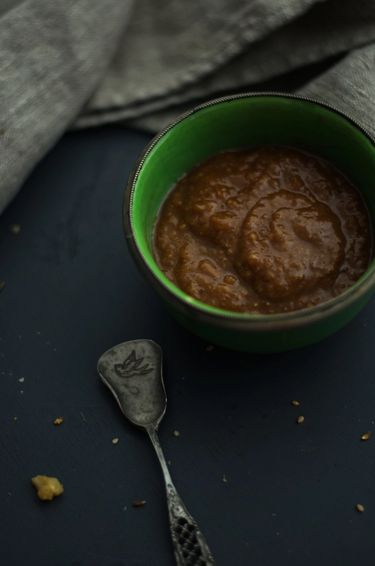
Once you've generously applied the miso glaze to the aubergines, you'll want to roast the aubergine halves until you get the consistency that you want — about 25-35 minutes. You can check if they're cooked by prodding the fleshiest part of the aubergine and seeing if it gives in, or you could test the flesh by carefully inserting a spoon all the way to the base of the aubergine.
Once cooked, you can garnish it whichever way you like. I garnish it with dukkah but you can also garnish it with scallions, microgreens or a sprinkle of toasted sesame seeds. Just get creative!
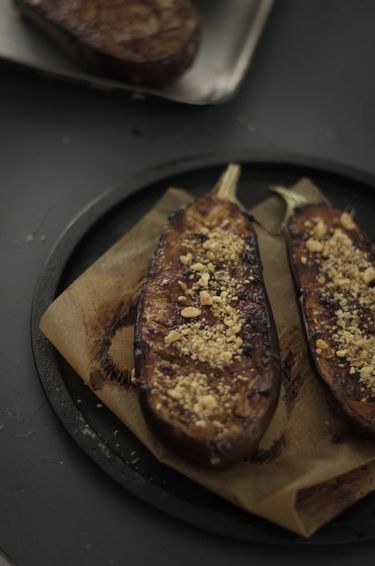
Discovering miso-glazed roasted aubergine was like a revelation. Easy to whip up, this recipe makes for a healthy light mid-week meal that you can serve with a side of steamed rice, noodles or simply by itself as an appetizer. It doesn't take long to make and can be kept in the fridge for leftovers the following days.
Vegan miso aubergine with a walnut dukkah garnish
2 reviews
Description
Vegan miso-glazed roasted aubergine with dukkah — an Egyptian condiment consisting of a mixture of herbs, nuts, and spices.
Information
- Servings
- 4halves of aubergine
- Preparation time
- 15minutes
- Cooking time
- 30minutes
Ingredients
- 2medium sized aubergines
- 60grmiso
- 18mlmaple syrup
- 12mlsoy sauce
- 4mltoasted sesame oil
- 8grroot ginger, peeled and grated (thumb sized)
- 1garlic clove, peeled and crushed
- 24grwalnuts
- 8grwhite sesame seeds
- 10coriander seeds (1/4 tsp)
- 10cumin seeds (1/4 tsp)
- —salt, a pinch
Method
1. Prepare the aubergines
First preheat the oven to 180°C, in fan mode. Then begin preparing the aubergines by slicing the two aubergines lengthwise so that you get four halves. Score the flesh in a diamond pattern making sure not to cut through the skin. Line a baking sheet with greaseproof paper and lay the aubergines on top, skin down.
2. Prepare the miso glaze
Mix the miso, maple syrup, soy sauce, sesame oil, ginger and garlic with 1-2 tablespoons of water to make a smooth paste. Spread the paste onto the slices of aubergine until it begins to seep into the flesh.
3. Roast the aubergines
Roast for 25-35 minutes until golden brown and soft.
4. Prepare the dukkah (walnut spice mix)
Whilst the aubergines are roasting, prepare the dukkah. Mix all the ingredients together, using pestle and mortar to grind the walnuts and spices to a rough crumble. You can also use a blender, on pulse mode.
5. Serve the aubergines
Check the aubergine to see that it is cooked through. Once out of the oven, garnish with the dukkah and serve with a side of rice, noodles or enjoy it as an appetizer.
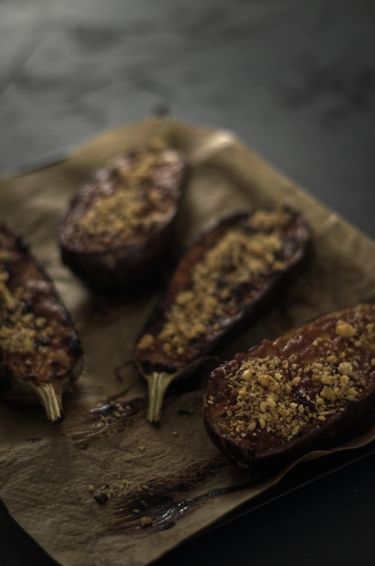
Want another nutty dish? Check out my recipe for watermelon gazpacho with cashews.
